Table of Contents
We’ve mentioned how we use our pressure washer to revive various things around the house – like outdoor furniture and even an indoor rug – but we still hear from people who fear that it’s complicated to set up or expensive to buy or hard to control… and the good news is that it’s none of those things. So this post is a comprehensive start-to-finish guide for anyone who’s finally ready to get their pressure washing feet wet (maybe even literally).
Pressure washing is an easy, affordable, and TOTALLY AWESOME way to keep your outdoor spaces looking fresh. So I’m walking you through everything from setting it up and turning it on, to where and how we use ours. It makes such an insane difference every spring, I’d even call it a DIY VIP.
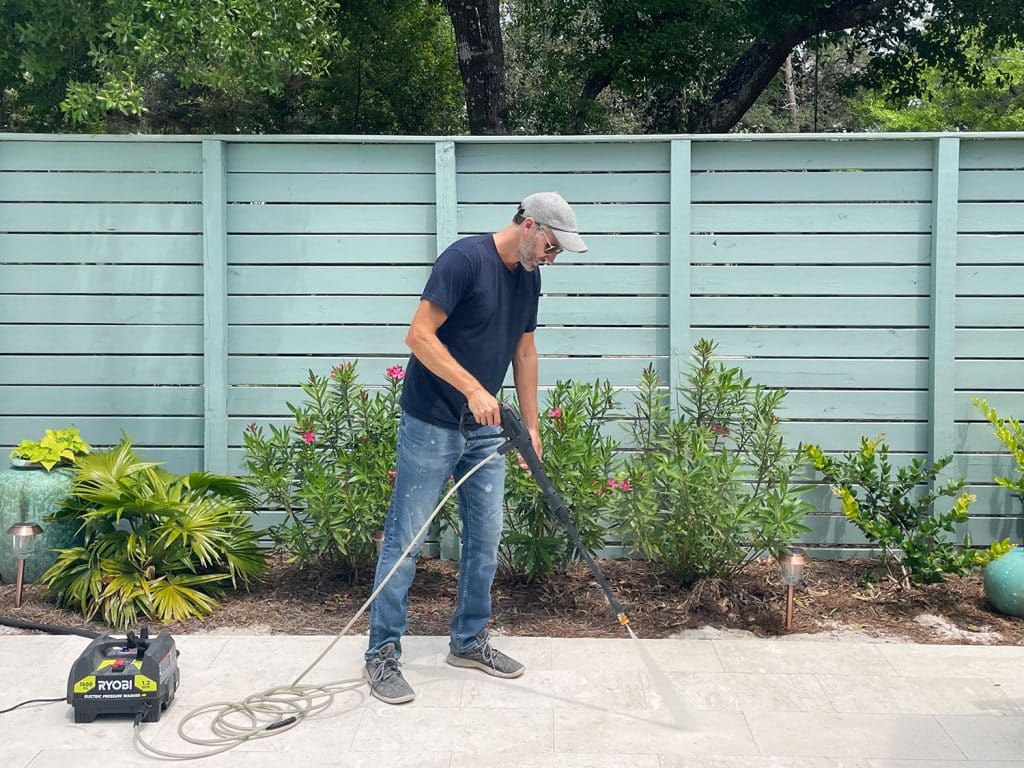
We were a bit intimidated the first time we tried pressure washing nearly 10 years ago. The cumbersome gas-powered machine we rented for a day was so big it didn’t even fit in our car! So I TOTALLY understand anyone with PWH (pressure washing hesitation).
But that all changed when we found a GREAT pressure washer that’s super compact and easy to use – this $99 Electric Pressure Washer from Ryobi. Both Sherry and I use it regularly – and neither of us have any issues controlling it or having enough power to get every single task on our list done. It’ll make a pressure washing convert out of just about anyone. We bought it many years ago with our own money and love it – so nothing about this glowing review is sponsored in any way.
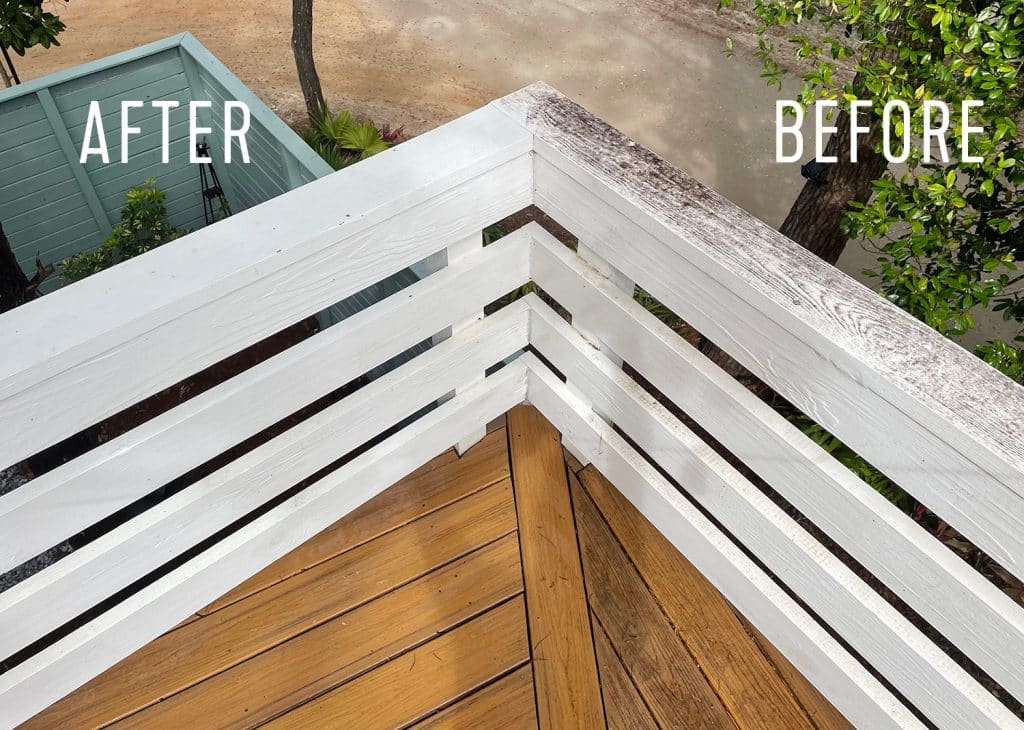
A Beginner’s Video Guide To Pressure Washing
We’ll cover all three of those topics in text & photos below, but if you want to see ALL of it in action and in real-time, the video below is for you. Oh yeah and there’s lots of that sweet sweet pressure washing footage that everyone’s eyeballs can’t help but love. And more importantly, several cameos by our dog Penny.
Note: You can also view this video on YouTube.
Setting Up Your Electric Pressure Washer
Again, we currently own this $99 Electric Pressure Washer from Ryobi. We bought it for our beach house in 2018, and when we moved we opted to bring it with us instead of an older/larger version we had before – just because this one is so compact and reliable and (most importantly) GOOD AT CLEANING. There are definitely more powerful (and more expensive) options out there, but this pressure washer has always met our needs. Always. In fact, we don’t even use it on it’s highest setting. That’s how adequately powerful it is. Plus it’s pretty much the most affordable option out there and we especially love that it’s compact and easy to use. So unless you have a special need for something more intense, this is a fantastic option.
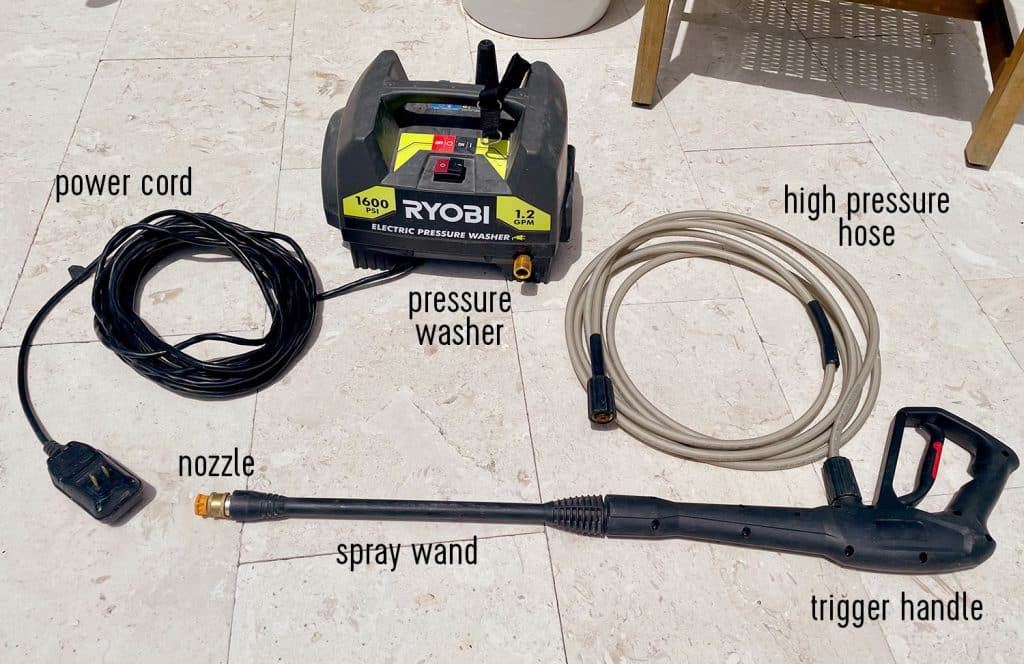
The box includes everything shown above, you just need to supply water (via a garden hose) and power. And, as we show in the video, set-up is pretty much as easy as just connecting those two things!
Step 1: Assemble Your Wand
We typically store our wand and trigger handle assembled, but coming fresh out of the box you’ll need to lock these two pieces together with a simple twist.
Step 2: Connect Your High-Pressure Hose
The high-pressure hose is what carries the pressurized water from the machine to the spray wand. Each end has an identical black threaded collar. One end connects to your trigger handle, the other to the brass connection on the pressure washer. Just hand tighten until they’re both secure.
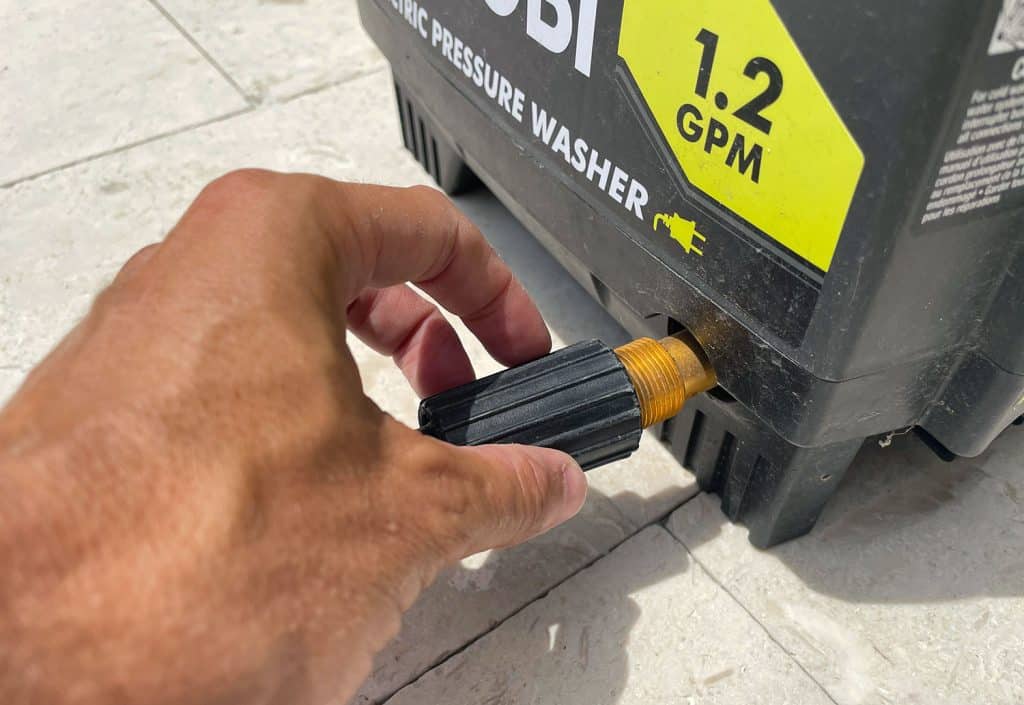
Step 3: Connect Your Garden Hose
On the opposite side of the pressure washer, there’s a black threaded connection that fits a regular garden hose. Attach your hose tightly just like you would screw it onto your home’s hose bib.
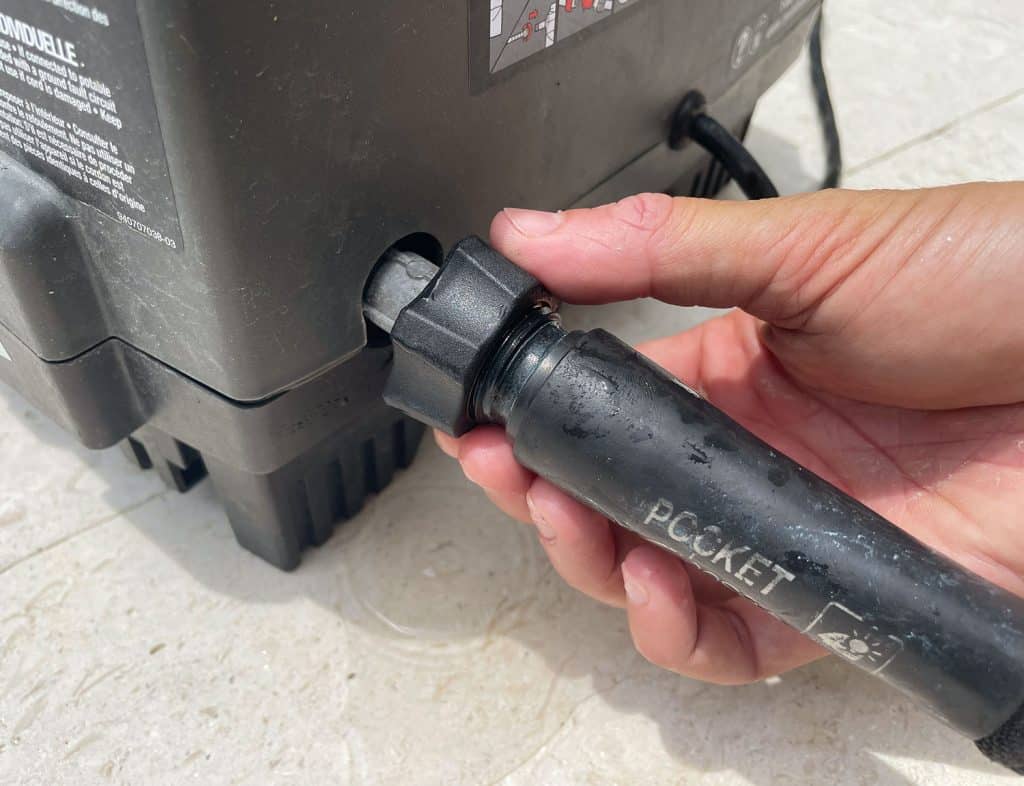
Step 4: Select & Attach Your Nozzle
This pressure washer comes with 3 nozzle options that offer different levels of pressure for different applications (you can also purchase others as needed). There’s a handy guide on the top of the device that explains the differences between the three, along with holes to store them in.
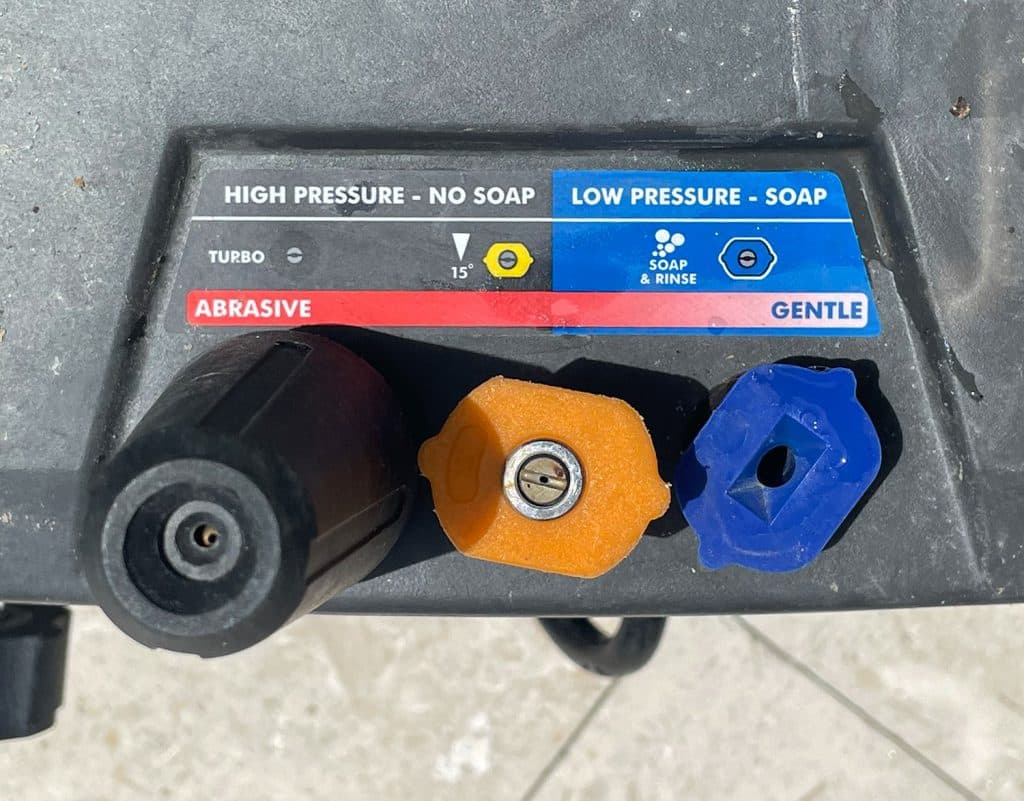
As we describe in the video, we almost EXCLUSIVELY use the middle (medium pressure) orange nozzle. It’s kind of the Goldilocks of options, giving us the “just right” amount of pressure for cleaning patios, decking, outdoor fabrics, and more. Plus, you can always adjust the pressure you’re applying by simply holding your wand closer or farther from the surface you’re cleaning.
The distance matters – so try to watch the video above whenever you can to see more of what we mean. Held too close to something, even the medium pressure nozzle can strip paint or stain off of wood – but spraying with adequate distance can mean zero removal of anything but dirt and grime – which is SO satisfying, and leaves lots of surfaces outside looking like new.
To attach your selected nozzle at the end of the wand, you just pull down on the brass collar and place the nozzle into the opening. Releasing the collar locks it into place.
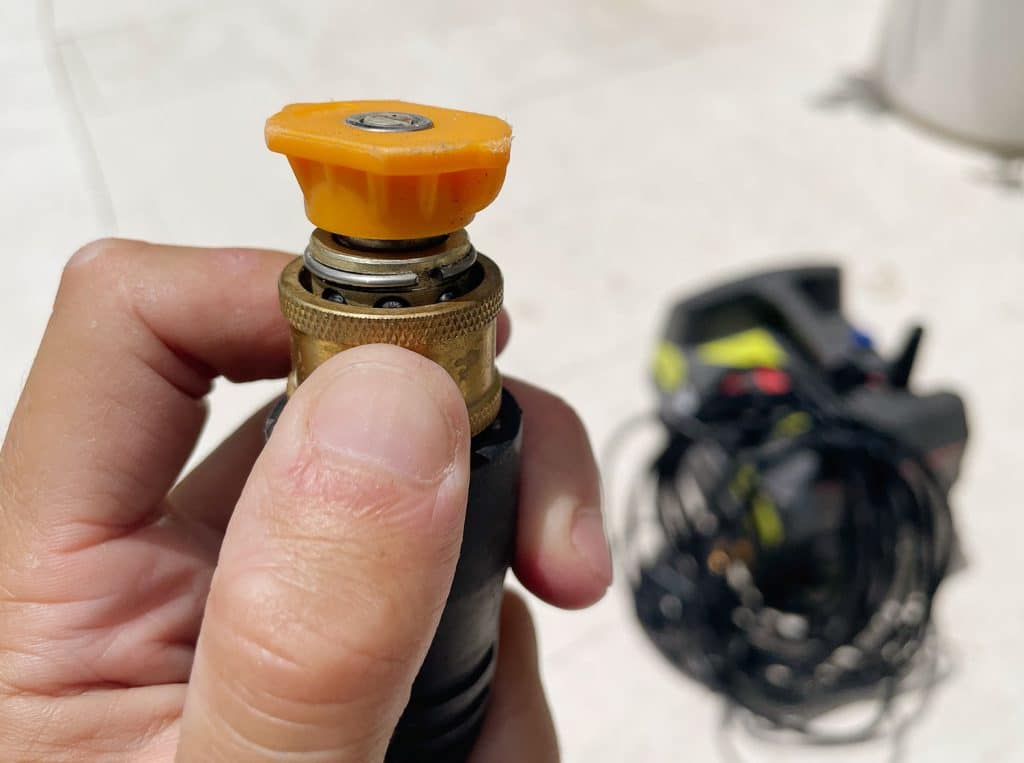
This completes all of the water connections you need to make, which means you can now…
Step 4: Turn On Your Hose
With your water connections secure, you can now turn on the water at your hose bib. It’s a good idea to open that sucker ALLLLLLLL the way to be sure you’re getting the fullest flow possible from the hose.
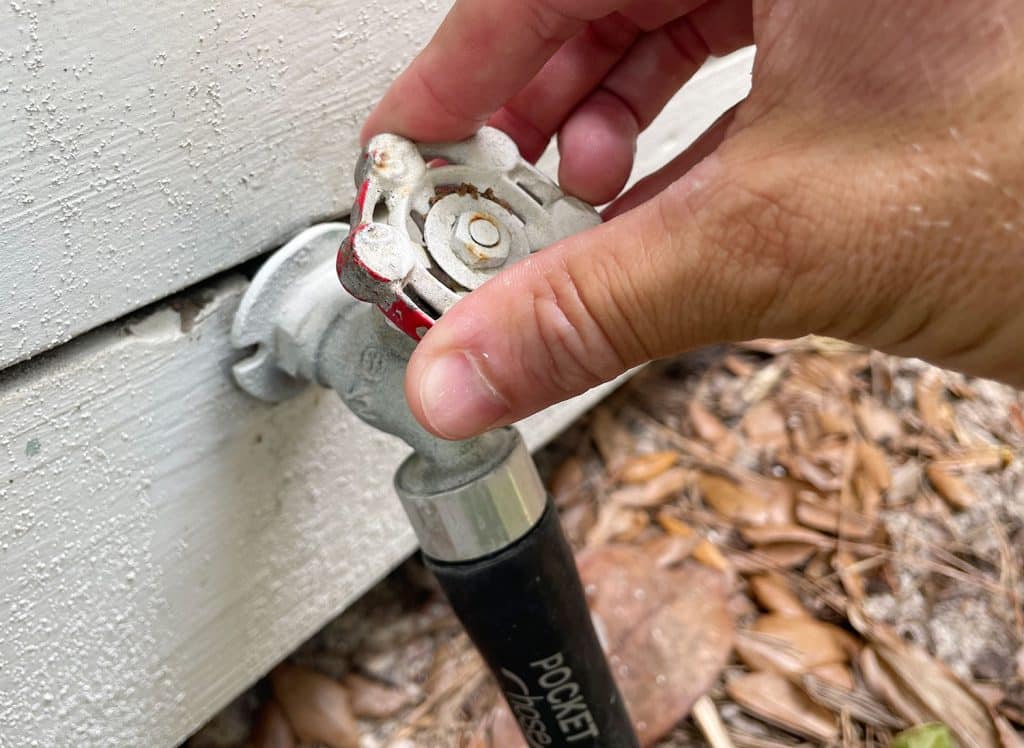
You also want to check your hose for any kinks, leaks, or other knots that might prevent the water from flowing freely to your pressure washer. It’s also a good idea to squeeze the trigger on your pressure washer for several seconds to make sure the water is coming out steadily before proceeding.
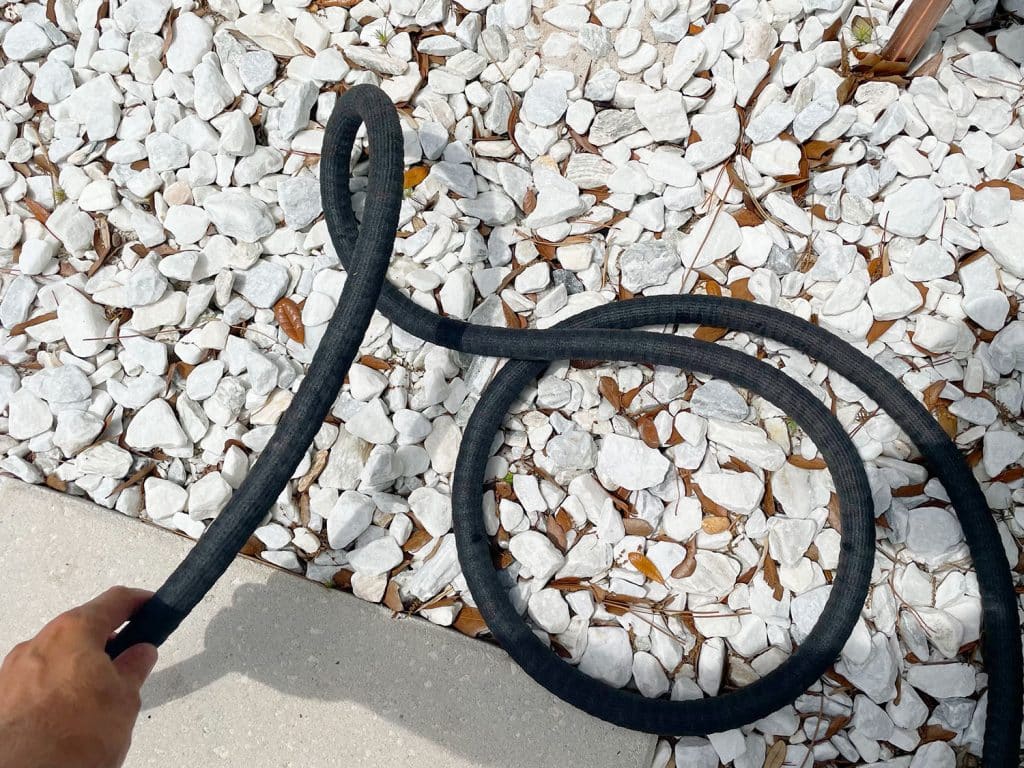
You may notice that we’re using one of those expandable “pocket hoses” that shrink up when it’s not full of water. We love these hoses because they’re less bulky and cumbersome than traditional hoses, but some may dissuade you from using them with certain pressure washers (we’ve personally never had any issue using ours).
Step 5: Connect Your Power
With your water good to go, now you can plug in your pressure washer. Ours comes with a SUPER long cord, so you probably won’t need an extension cord, but you can always use one if necessary.
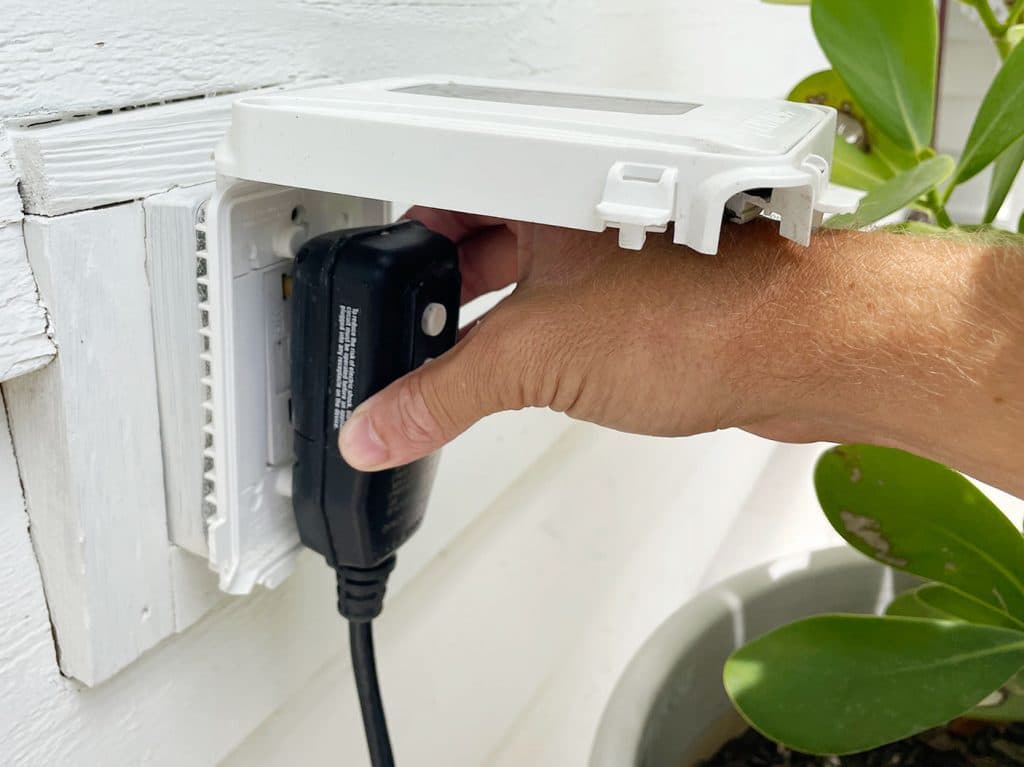
If you are connecting an extension cord, just be sure to elevate the connection point of the two plugs (like on a table, chair, or bucket) to prevent water from dripping toward the plugs.
Step 6: Turn On Your Pressure Washer
Turn on the pressure washer using the black button on the top of the machine. You will immediately hear the device engage and you may see your high-pressure hose stiffen as pressurized water fills it up. If this does not happen, try pressing the test & reset buttons on the plug or on your GFI outlet. Those can be common culprits for your power not working.
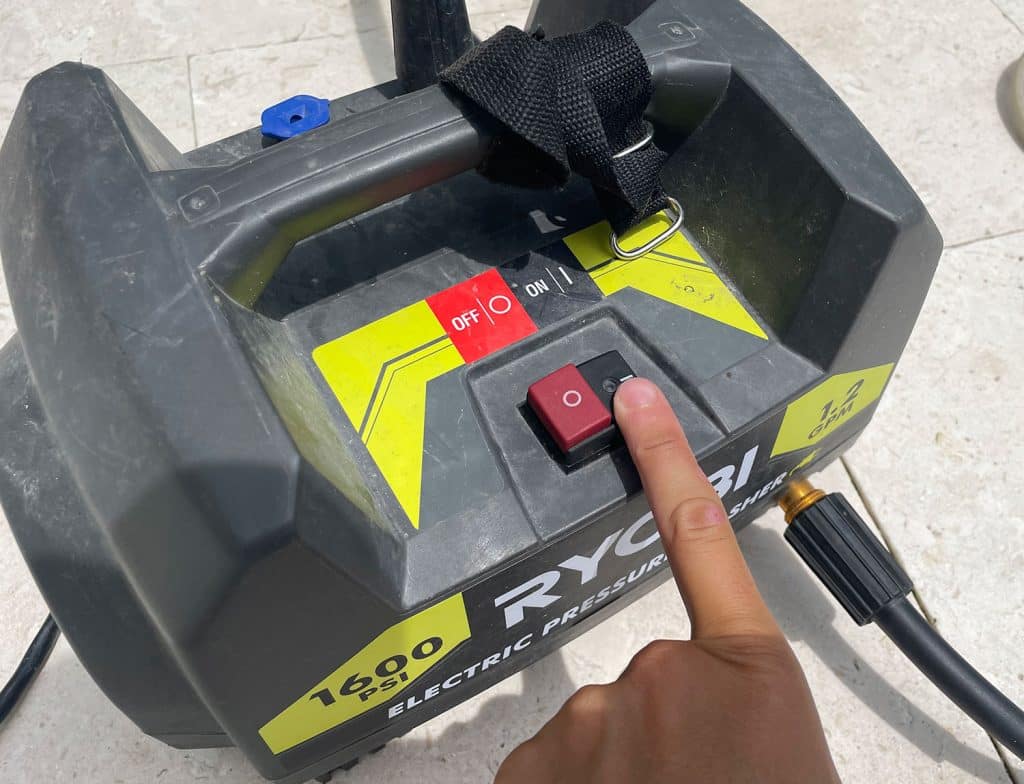
Now your pressure washer is set up and ready for use!
Before You Start Cleaning With Your Pressure Washer
We cover a lot of tips along the way during the video (watching that is truly the best way to get a full primer on pressure washing), but here are a handful of things to keep in mind before you start your first pressure washing adventure.
- Wear close-toed shoes and pants to help protect your feet and lower legs from any accidental pressurized spray. A direct, close-range spray can sting or even break the skin.
- Clean top to bottom. If your to-do list includes multiple surfaces, start with the higher ones (railings, patio umbrellas, etc) and work down to lower ones (decks, patios).
- Start slow and test in an inconspicuous spot first. It’s always good to start in a hidden spot (like the back of a pillow or the area of your deck that’s under your outdoor sofa). If it’s your first time pressure washing a particular material or surface, start with low pressure and gradually increase it as needed (by bringing your wand closer or changing nozzles) to make sure you’re not damaging the surface. Don’t start by blasting something with the nozzle mere inches away ever.
- Beware of sensitive materials like windows, soft woods, & vinyl siding that can be easily broken or damaged with too much pressure. We generally tend to stick to cleaning concrete, outdoor stone or tile, Trex or wood decking, brick paths or patios, wood or metal railings, and outdoor furniture/pillows as well as outdoor AND indoor rugs (more on that here). You obviously want the nozzle further away from fabric than, say, concrete.
- Mind your cords. This pressure washer is super light and portable, but keep an eye on your power cord and water hoses as you move it to make sure you’re not kinking anything or creating tripping hazards.
What We Clean With Our Pressure Washer
We typically break out our pressure washer 2-3 times a year to keep our various outdoor spaces looking fresh and clean. Between all of our trees, our clay/sand road, and the salty beach air, things can get grimy – so we usually do a pretty thorough cleaning in the spring to wash off the dirt, pollen, or mildew that collected on things over the winter. Then we might do some quicker “touch up” cleanings as needed in the summer and fall.
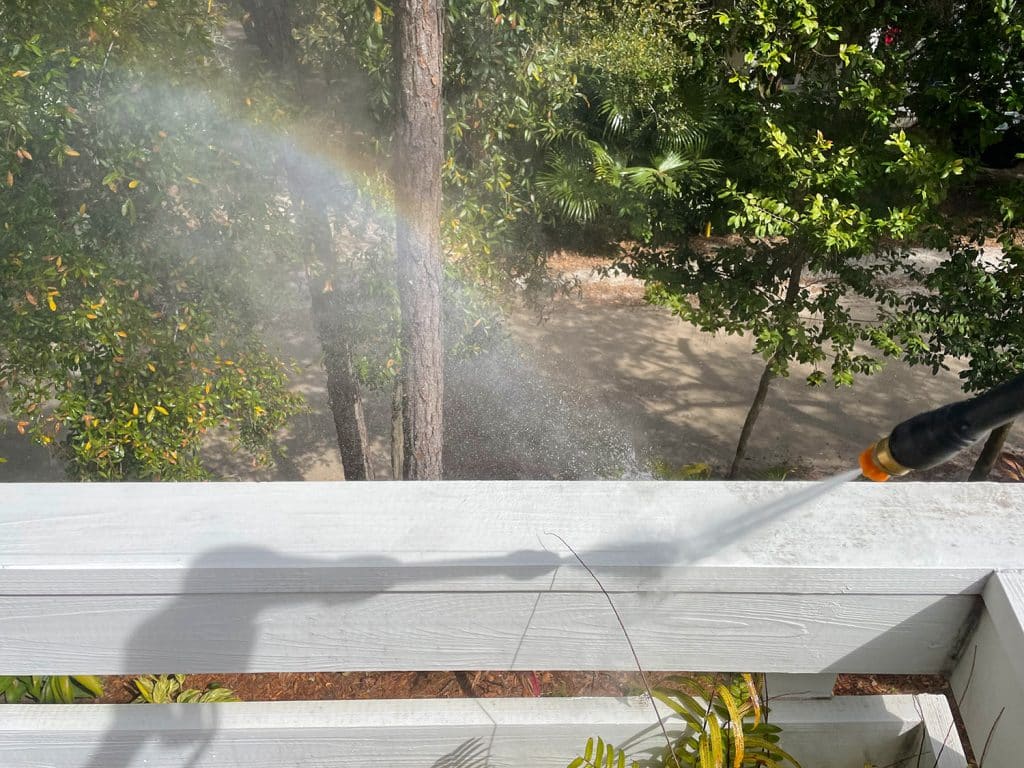
We use it on a variety of surfaces, but here are the primary ones that we’ll cover today:
- Composite Decking
- Painted Railings
- Outdoor Fabrics
- Stone Patios
Composite Decking
We have Trex decking on our porches and we’ve found the pressure washer to be a great way to get dirt, dust, and sand build-up off of them. The woodgrain texture on the Trex catches a lot of grime and we hadn’t cleaned our upstairs deck in a while, so it had quite the layer of black tree dirt. That made the job super satisfying though…
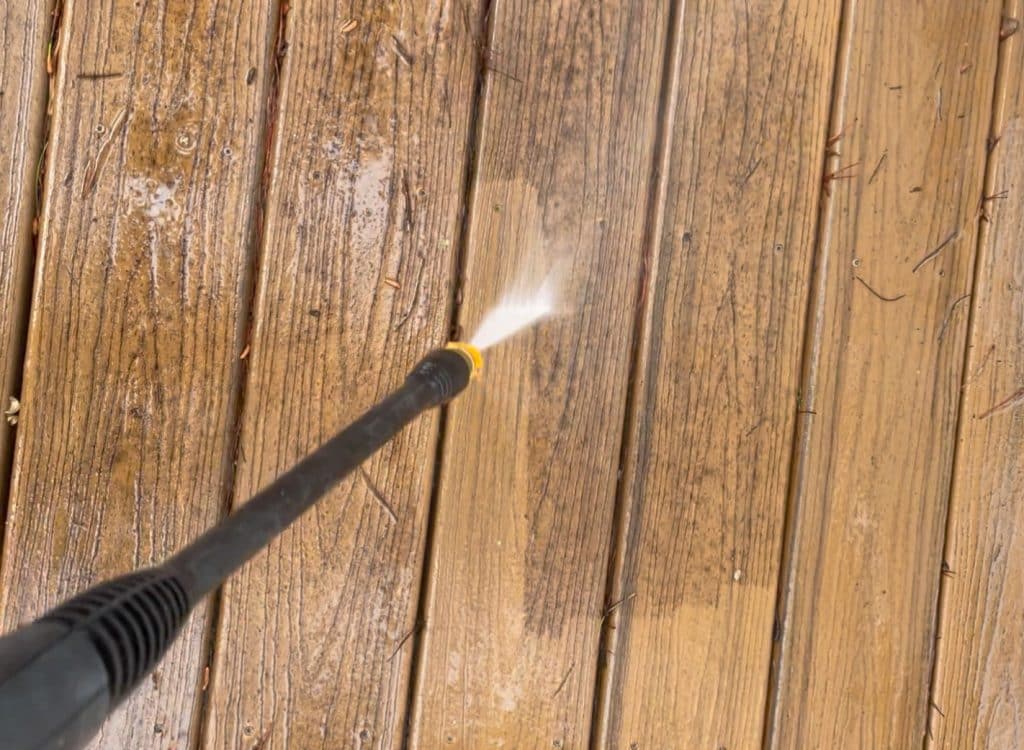
Doing that large upstairs deck was pretty tedious because we had to be slow & systematic so we didn’t miss any boards (sometimes it’s hard to see what’s still dirty once everything has gotten wet). So before doing my downstairs decks I bought this $40 surface cleaning attachment for electric pressure washers that a bunch of you have recommended for doing larger “floor” surfaces faster. Boy was it a game-changer!
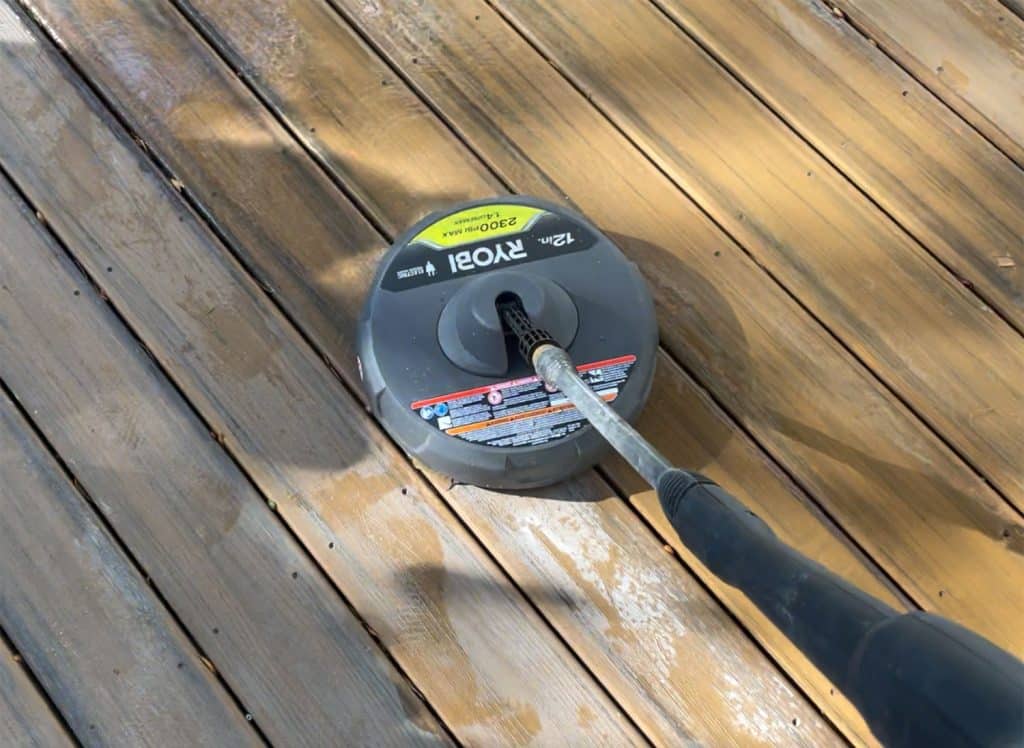
It attaches to my spray wand just like any other nozzle does, but provides a much larger 12″ cleaning surface, which made pressure washing my decks SO. MUCH. FASTER.
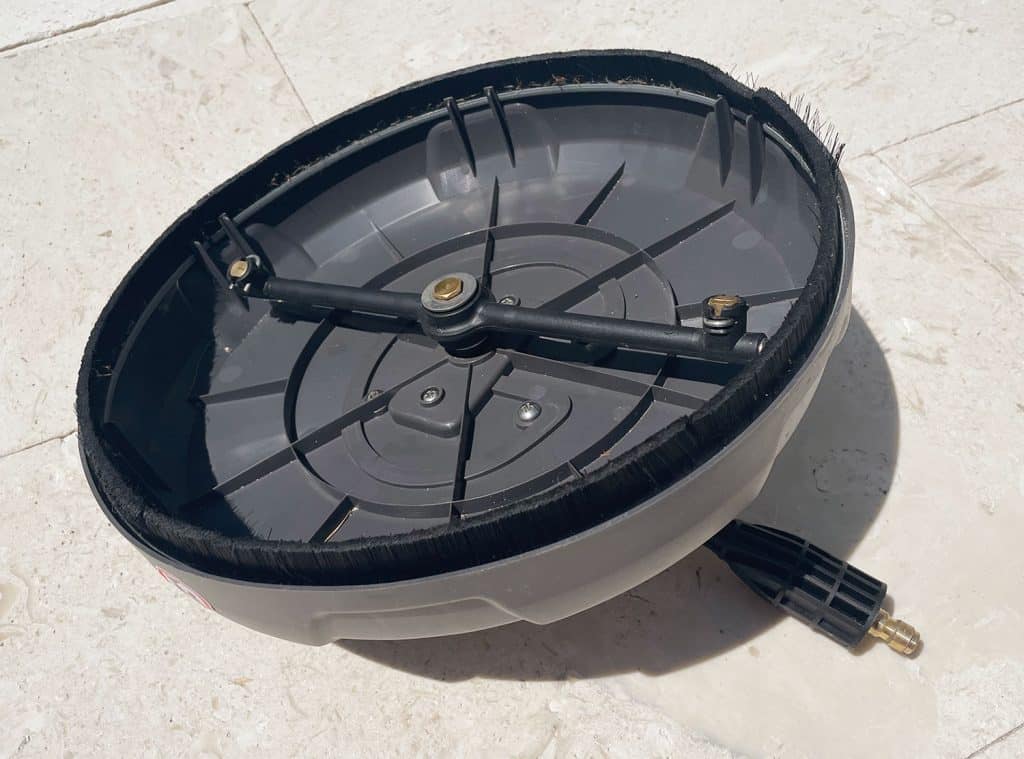
Not only was it faster, but I didn’t worry as much about leaving “streaks” if I missed a spot or only cleaned part of a particular board. You can see below that our decks can get a lot of sandy footprints and settled sand on them. But they look much fresher now!
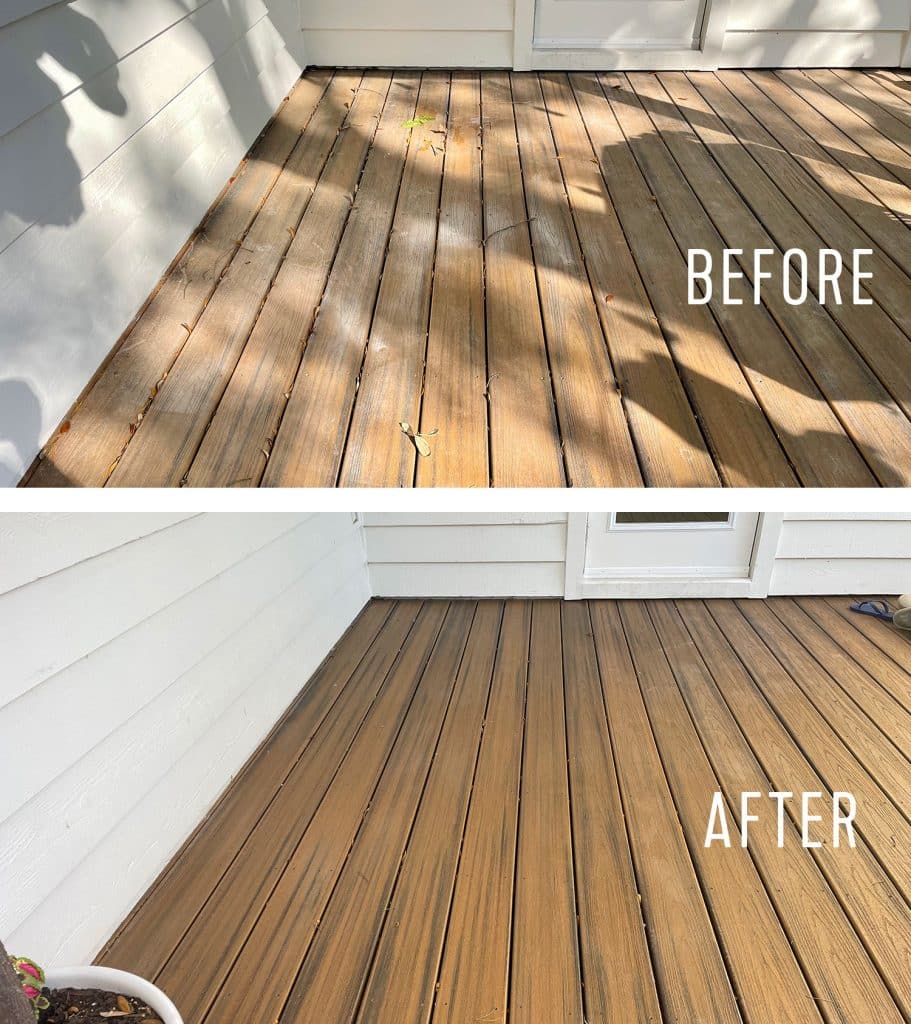
Railings
Another area that we hadn’t cleaned in a while was the upstairs deck railings, which had a build-up of tree dirt on them just like the Trex decking.
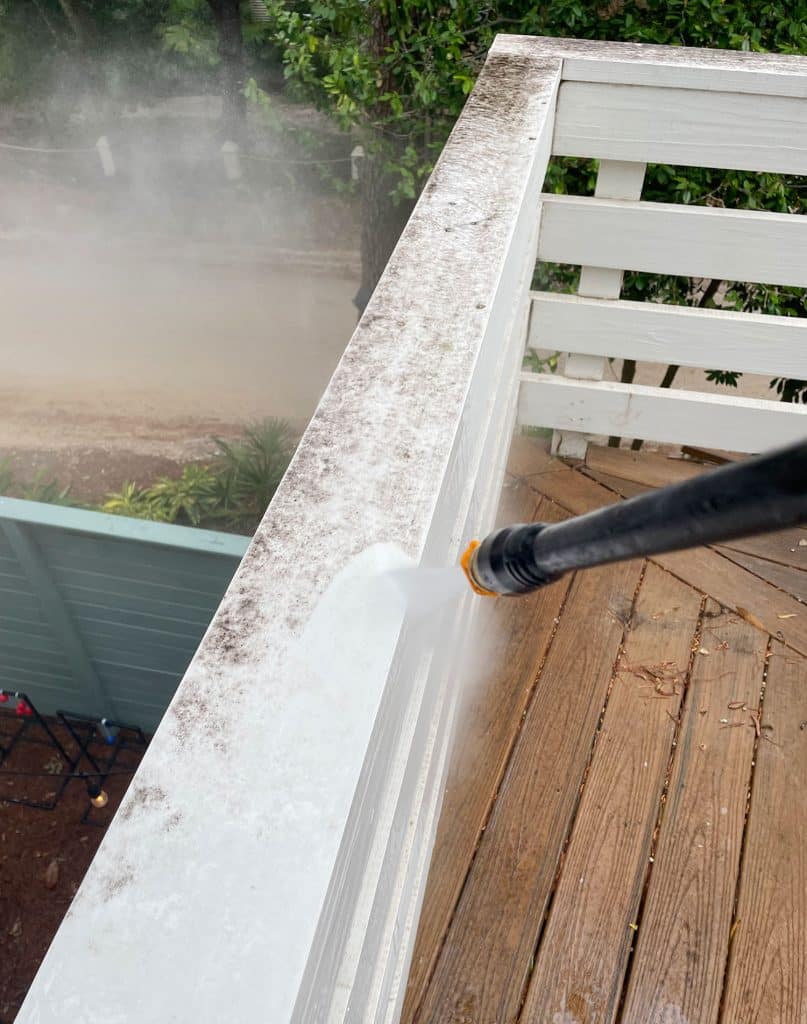
These railings are painted wood, and you should always use a bit of caution when pressure washing painted surfaces because the pressure can cause the paint to chip or flake. Also, if any areas have started to rot beneath the paint, the pressure washer can make the situation worse.
We just always keep a close eye on the surface as we clean, and lessen the pressure (step back!) or skip a particular spot if the paint isn’t holding up. If your biggest nightmare is some flaked paint, I’m also here to assure you that a few paint touch-ups aren’t a big deal. We’ve done them and they’re never detectible once it’s dry.

Outdoor Fabrics
We’ve definitely extended the life of more than a few outdoor pillows and cushions thanks to our pressure washer. It’s just especially important with fabrics to take it slow because too much pressure can cause the fabric to tear or fray. So start on the back and with low pressure, especially if it’s the first time you’re cleaning that material.
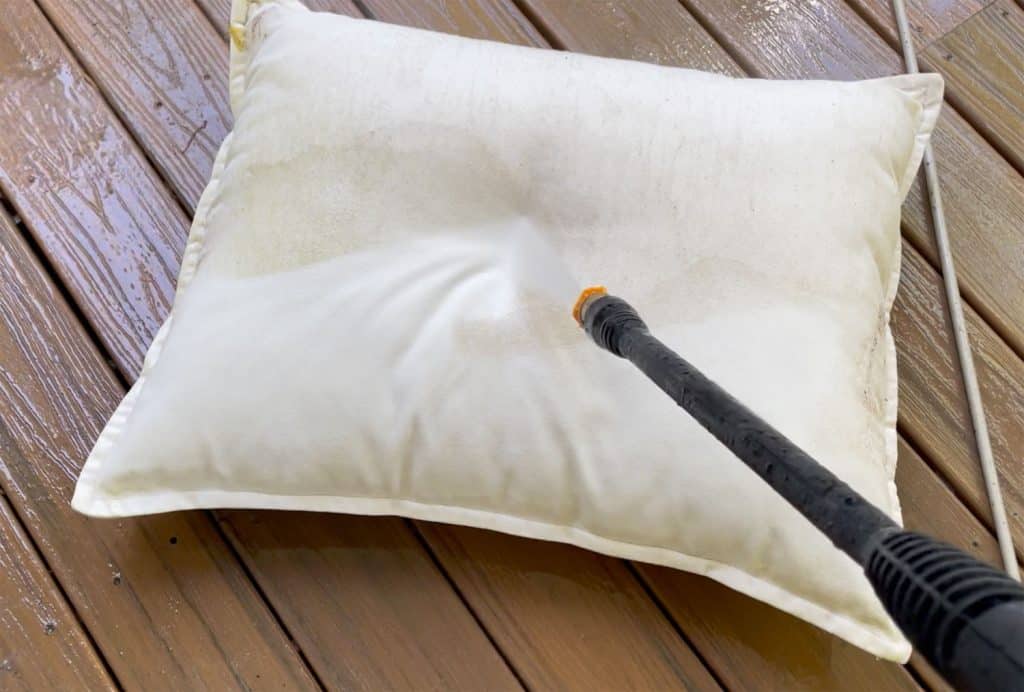
Also, keep in mind that the process may not be perfect. Some stains may only get lighter, not disappear entirely. So you may need to attack certain spots with an outdoor cleaner or fabric cleaner to finish the job. But for us, we find the pressure washer does the bulk of the work getting our outdoor fabrics ready for spring. Hot tip: put them in the sun to dry. That does a great job of lightly bleaching some more stubborn stains than if you set them out to dry in the shade.
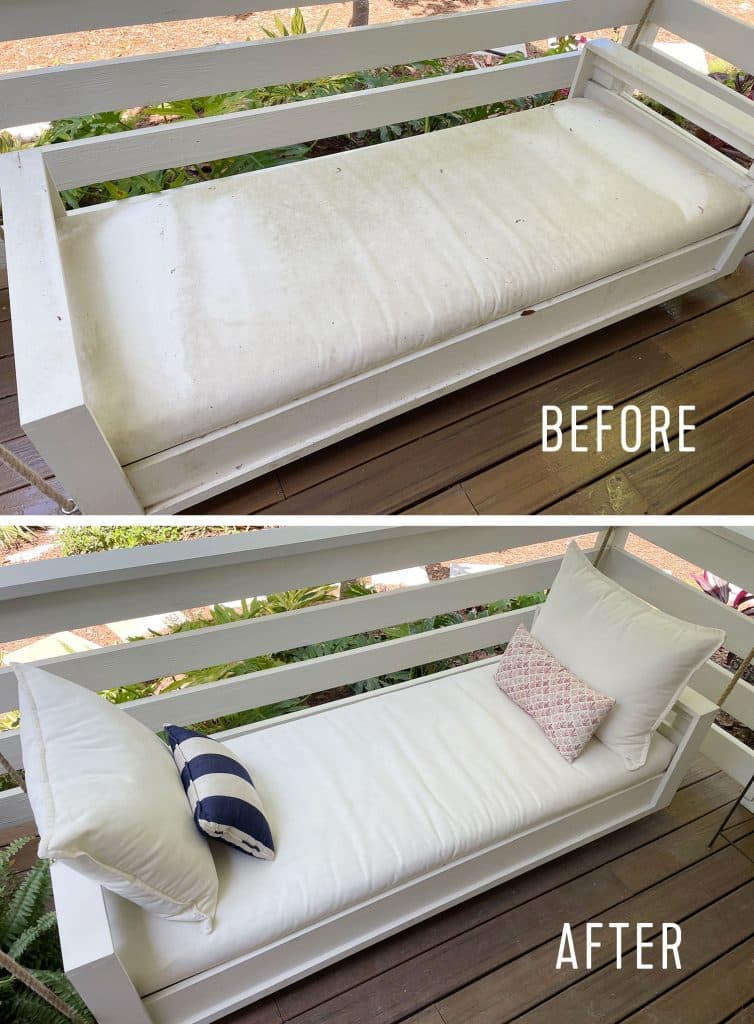
Stone Patio
Pressure washing is a great way to get patios, driveways, sidewalks, and even some decking to look new again. This was the first season we used it to clean the stone patio around our pool, which had collected a lot of green scum in some of the more shaded areas of the yard (under and behind the lounge chairs for example).
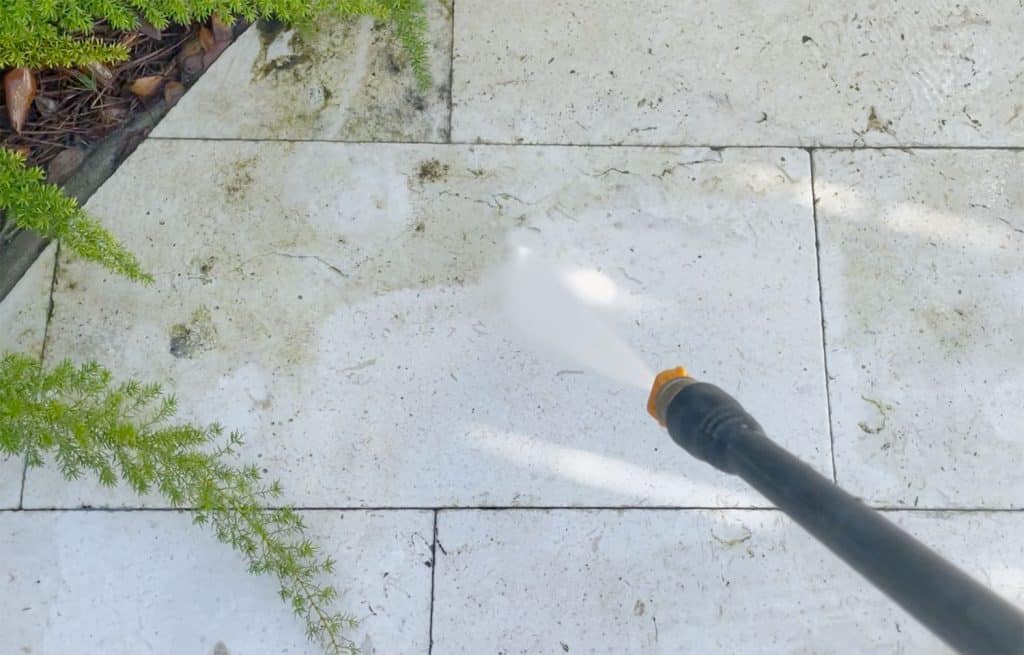
The video shows how satisfying this really was, but the before & afters below give you an idea as well. It’s a bit hard to tell because the stone itself has some darker shell “spots” in it (and the surface is wet in the after shot), but this whole area looks totally redeemed.
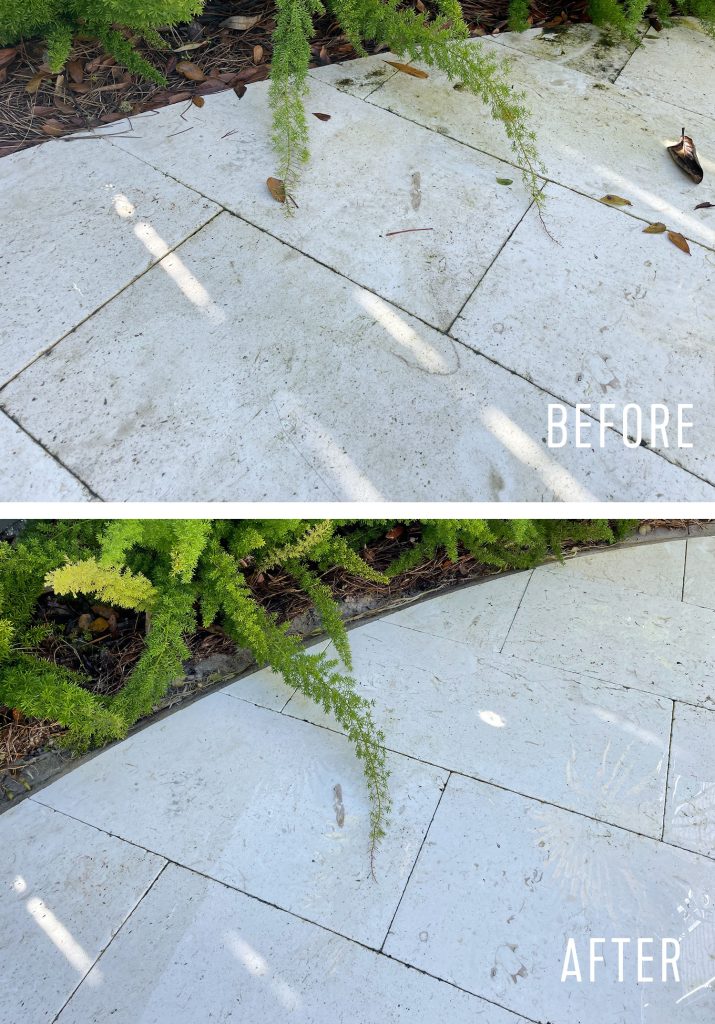
Such a difference.
When you’re cleaning patios or other stone surfaces, just be mindful of any polymeric sand (or regular sand) that you may have between the cracks. The pressure washer may blow that loose and you’ll need to refill it.
We also get asked very often about whether or not we add some sort of soap or cleaner to our pressure washer. While the machine DOES come with a way to wash with soap (it includes a hose that you can attach and connect to your bottle of soap), honestly, we’ve never used it. We just spray outdoor cleaners on certain items (mainly stubborn fabric stains – for example, we use this fabric cleaner) by hand and then pressure wash them to move those suds all around and rinse them away.
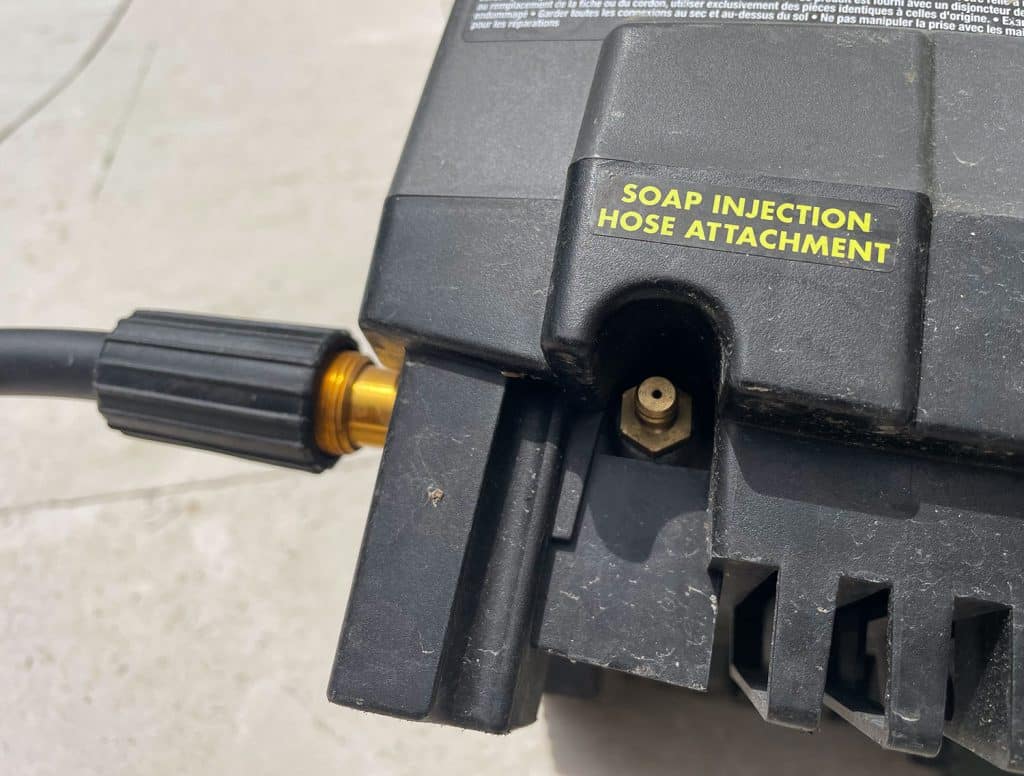
The last thing to keep in mind when cleaning outdoor fabrics is to make sure you have a sunny spot to let them FULLY dry. Otherwise, you may just encourage more mildew build-up.
Other Uses For Your Pressure Washer
While those are the ways that we currently use our pressure washer, there a TONS of other ways they can be useful around the house. Here are some previous posts we’ve written about other pressure washing adventures:
Putting Your Pressure Washer Away
Once you’ve finished your cleaning, disconnecting and storing your pressure washer is even easier than setting it up. You’re basically reversing the steps:
- Turn it off and unplug it
- Turn off your water
- Spray the wand for several seconds to release the water pressure (it will make disconnecting the hoses easier)
- Disconnect your garden hose
- Disconnect your high-pressure hose from the pressure washer (we leave it attached to our spray wand, but you can disconnect that end too)
Once everything is disconnected, there’s a handy velcro strap on the handle of the machine to help you wrangle all of your cords and hoses. It’s one of our favorite features because it makes storing it so much easier! You can see it in action in the video 😉
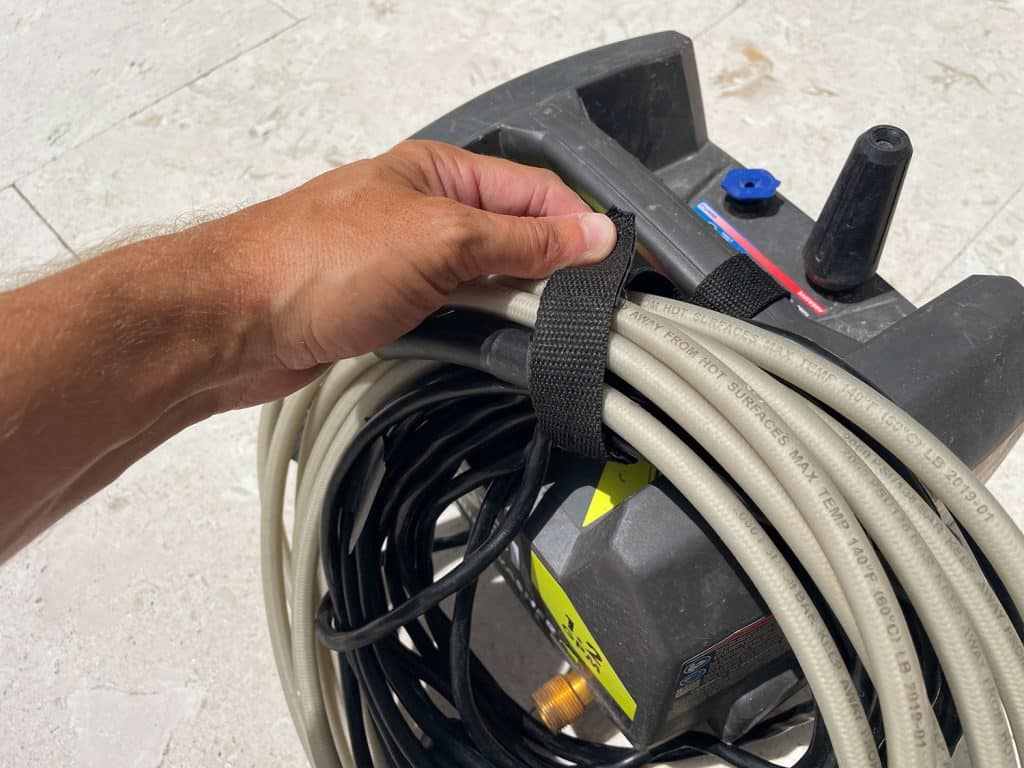
So, there you have it. All the info I can possibly think of on the topic of pressure washing. I hope it leaves you feeling confident that you can tackle this project yourself (you can!). I’m ridiculously glad that we tried one out many years ago and have never regretted owning one since!
Sidenote: we finally better-categorized and updated our Amazon shop to include a lot of the more recent things we have been loving – like Sherry’s beloved robot vacuum, some new favorite family board games, our tried and true beach gear, favorite recent reads, etc – so that’s all right here.
*This post contains affiliate links, so we may earn a small commission when you make a purchase through links on our site at no additional cost to you.
